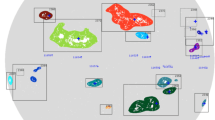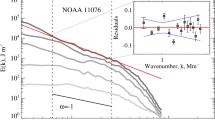Abstract
Magnetic elements of the solar surface are studied (using the 6173 Å Fe i line) in magnetograms recorded with the high-resolution Solar Dynamics Observatory (SDO)/Helioseismic and Magnetic Imager (HMI). To extract some statistical and physical properties of these elements (e.g. filling factors, magnetic flux, size, and lifetimes), we employed the region-based method called Yet Another Feature Tracking Algorithm (YAFTA). An area of \(400^{\prime\prime}\times400^{\prime\prime}\) was selected to investigate the magnetic characteristics in 2011. The correlation coefficient between filling factors of negative and positive polarities is 0.51. A broken power-law fit was applied to the frequency distribution of size and flux. Exponents of the power-law distributions for sizes smaller and greater than \(16~\mbox{arcsec}^{2}\) were found to be −2.24 and −4.04, respectively. The exponents of power-law distributions for fluxes lower and greater than \(2.63\times 10^{19}~\mbox{Mx}\) were found to be −2.11 and −2.51, respectively. The relationship between the size [\(S\)] and flux [\(F\)] of elements can be expressed by a power-law behavior of the form of \(S\propto F^{0.69}\). The lifetime and its relationship with the flux and size of quiet-Sun (QS) elements during three days were studied. The code detected patches with lifetimes of about 15 hours, which we call long-duration events. We found that more than 95% of the magnetic elements have lifetimes shorter than 100 minutes. About 0.05% of the elements had lifetimes of more than six hours. The relationships between size [\(S\)], lifetime [\(T\)], and flux [\(F\)] for patches in the QS yield power-law relationships \(S\propto T^{0.25}\) and \(F\propto T^{0.38}\), respectively. Executing a detrended-fluctuation analysis of the time series of new emerged magnetic elements, we found a Hurst exponent of 0.82, which implies a long-range temporal correlation in the system.

















Similar content being viewed by others
References
Abramenko, V.I., Longcope, D.W.: 2005, Astrophys. J. 619, 1160. DOI . ADS .
Alipour, N., Safari, H.: 2015, Astrophys. J. 807, 175. DOI . ADS .
Arish, S., Javaherian, S., Safari, H., Amiri, A.: 2016, Solar Phys. 291, 1209. DOI . ADS .
Aschwanden, M.J.: 2011, Self-Organized Criticality in Astrophysics, Springer, Chichester. DOI . ADS .
Buldyrev, S.V., Goldberger, A.L., Havlin, S., Mantegna, R.N., Matsa, M.E., Peng, C.-K., et al.: 1995, Phys. Rev. E 51, 5084. DOI .
Burtseva, O., Petrie, G.: 2013, Solar Phys. 283, 429. DOI . ADS .
Clauset, A., Shalizi, C.R., Newman, M.E.J.: 2009, SIAM Rev. 51(4), 661. DOI .
Close, R.M., Parnell, C.E., Longcope, D.W., Priest, E.R.: 2005, Solar Phys. 231, 45. DOI . ADS .
DeForest, C.E., Hagenaar, H.J., Lamb, D.A., Parnell, C.E., Welsch, B.T.: 2007, Astrophys. J. 666, 576. DOI . ADS .
de Wijn, A.G., Stenflo, J.O., Solanki, S.K., Tsuneta, S.: 2009, Space Sci. Rev. 144, 275. DOI . ADS .
Gošić, M., Bellot Rubio, L.R., Orozco Suárez, D., Katsukawa, Y., del Toro Iniesta, J.C.: 2014, Astrophys. J. 797, 49. DOI . ADS .
Gošić, M., Bellot Rubio, L.R., del Toro Iniesta, J.C., Orozco Suárez, D., Katsukawa, Y.: 2016, Astrophys. J. 820, 35G. DOI . ADS .
Hagenaar, H.J., Schrijver, C.J., Title, A.M., Shine, R.A.: 1999, Astrophys. J. 511, 932. DOI . ADS .
Hagenaar, H.J., Schrijver, C.J., Title, A.M.: 2003, Astrophys. J. 584, 1107. DOI . ADS .
Heneghan, C., McDarby, G.: 2000, Phys. Rev. E 62, 6103. DOI .
Honarbakhsh, L., Alipour, N., Safari, H.: 2016, Solar Phys. 291, 941. DOI . ADS .
Javaherian, M., Safari, H., Amiri, A., Ziaei, S.: 2014, Solar Phys. 289, 3969. DOI . ADS .
Lamb, D.A., Howard, T.A., DeForest, C.E., Parnell, C.E., Welsch, B.T.: 2013, Astrophys. J. 774, 127. DOI . ADS .
Mandelbrot, B.B., Van Ness, J.W.: 1968, SIAM Rev. 10(4), 422. DOI .
McAteer, R.T.J., Gallagher, P.T., Ireland, J., Young, C.A.: 2005, Solar Phys. 228, 55. DOI . ADS .
Newman, M.E.J.: 2005, Contemp. Phys. 46, 323. DOI .
Parnell, C.E.: 2002, Mon. Not. Roy. Astron. Soc. 335, 389. DOI . ADS .
Parnell, C.E., DeForest, C.E., Hagenaar, H.J., Johnston, B.A., Lamb, D.A., Welsch, B.T.: 2009, Astrophys. J. 698, 75. DOI . ADS .
Peng, C.K., Buldyrev, S.V., Havlin, S., Simons, M., Stanley, H.E., Goldberger, A.L.: 1994, Phys. Rev. E 49, 1685. DOI .
Priest, E.R.: 2014, Magnetohydrodynamics of the Sun, Cambridge University Press, Cambridge. 9780521854719. ADS .
Rieutord, M., Rincon, F.: 2010, Living Rev. Solar Phys. 7, 2. DOI . ADS .
Scherrer, P.H., Bogart, R.S., Bush, R.I., Hoeksema, J.T., Kosovichev, A.G., Schou, J., et al.: 1995, Solar Phys. 162, 129. DOI . ADS .
Schou, J., Scherrer, P.H., Bush, R.I., Wachter, R., Couvidat, S., Rabello-Soares, M.C., et al.: 2012, Solar Phys. 275, 229. DOI . ADS .
Schrijver, C.J., Title, A.M., Hagenaar, H.J., Shine, R.A.: 1997a, Solar Phys. 175, 329. DOI . ADS .
Schrijver, C.J., Title, A.M., van Ballegooijen, A.A., Hagenaar, H.J., Shine, R.A.: 1997b, Astrophys. J. 487, 424. DOI . ADS .
Schrijver, C.J., Title, A.M.: 2003, Astrophys. J. 597, 165. DOI . ADS .
Shimazaki, H., Shinomoto, S.: 2007, Neural Comput. 19, 1503. DOI .
Solanki, S.K., Inhester, B., Schüssler, M.: 2006, Rep. Prog. Phys. 69, 563. DOI . ADS .
Stein, R.F.: 2012, Living Rev. Solar Phys. 9, 4. DOI . ADS .
Stangalini, M., Solanki, S.K., Cameron, R., Martínez, V.: 2013, Astron. Astrophys. 554, A115. DOI . ADS .
Wang, S., Liu, C., Liu, R., Deng, N., Liu, Y., Wang, H.: 2012, Astrophys. J. Lett. 745, L17. DOI . ADS .
Welsch, B.T., Longcope, D.W.: 2003, Astrophys. J. 588, 620. DOI . ADS .
Wiegelmann, T., Thalmann, J.K., Solanki, S.K.: 2014, Astron. Astrophys. Rev. 22, 78. DOI . ADS .
Yousefzadeh, M., Safari, H., Attie, R., Alipour, N.: 2016, Solar Phys. 291, 29. DOI . ADS .
Acknowledgements
The authors acknowledge the YAFTA group, that is, C.E. DeForest, H.J. Hagenaar, D.A. Lamb, C.E. Parnell, and B.T. Welsch, for making YAFTA results publicly available. The authors also thank NASA/SDO and the HMI science team.
Author information
Authors and Affiliations
Corresponding author
Ethics declarations
Disclosure of Potential Conflicts of Interest
The authors declare that they have no conflicts of interest.
Electronic Supplementary Material
Below is the link to the electronic supplementary material.
Rights and permissions
About this article
Cite this article
Javaherian, M., Safari, H., Dadashi, N. et al. Statistical Properties of Photospheric Magnetic Elements Observed by the Helioseismic and Magnetic Imager onboard the Solar Dynamics Observatory . Sol Phys 292, 164 (2017). https://doi.org/10.1007/s11207-017-1189-x
Received:
Accepted:
Published:
DOI: https://doi.org/10.1007/s11207-017-1189-x




